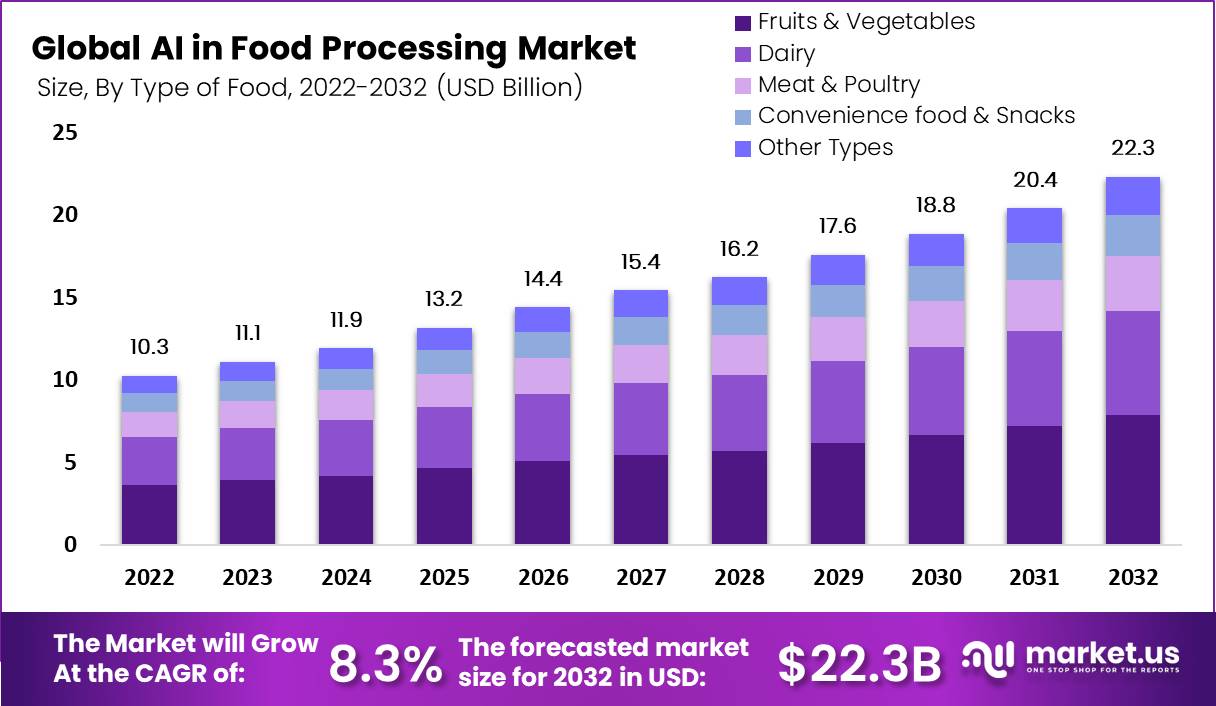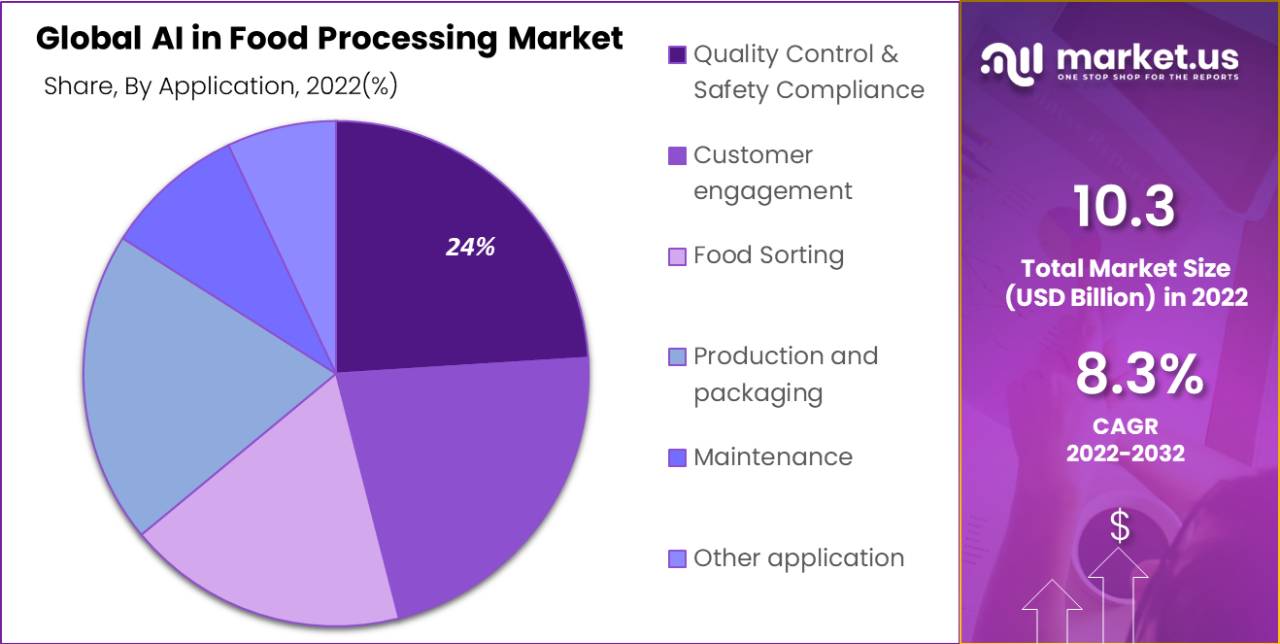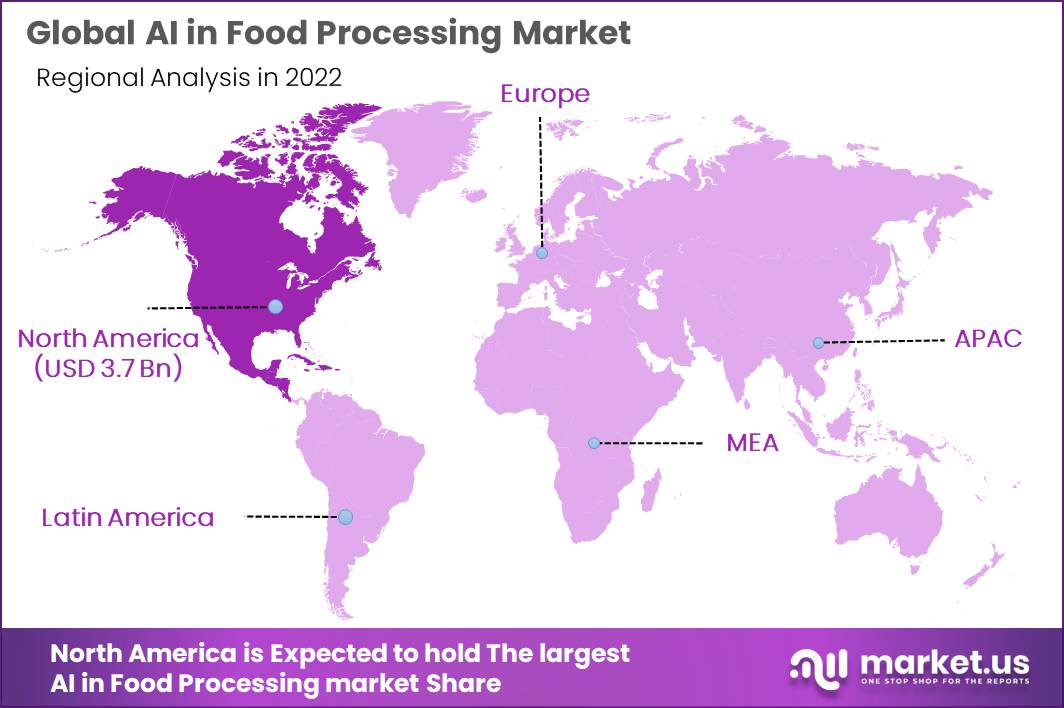New York, Feb. 05, 2024 (GLOBE NEWSWIRE) -- According to Market.us, In 2023, the gross revenue of the AI in Food Processing market is projected to reach USD 11.1 billion. A thorough analysis of the AI in food processing industry forecasts that the investment could experience an annual growth rate of 8.3% from 2023 to 2032. The analytical report delves into the fundamental determinants contributing to market growth, projecting an anticipated valuation of USD 22.3 billion by 2032.
The integration of Artificial Intelligence (AI) in food processing represents a transformative shift towards efficiency, safety, and sustainability in the food industry. AI technologies, including machine learning, computer vision, and robotics, are being deployed across various stages of food processing to optimize production lines, enhance quality control, and minimize waste. For instance, AI-driven predictive maintenance can forecast equipment failures before they occur, reducing downtime and maintaining continuous production flows. In quality control, computer vision systems are used to inspect and sort products with a level of precision and speed that surpasses human capabilities.
The AI in Food Processing Market is experiencing rapid growth, driven by the increasing demand for automation and precision in food production processes. The market's expansion is fueled by technological advancements, the need to comply with stringent food safety regulations, and the push for more sustainable production practices. As food processors seek to enhance efficiency, reduce costs, and improve product quality, the adoption of AI technologies is becoming a strategic imperative. This adoption is evident across small-scale specialty producers to large multinational corporations, highlighting the scalability and versatility of AI solutions. The market is characterized by a wide range of AI applications, from robotic sorting systems to AI-powered supply chain optimization tools.
Tap into Market Opportunities and Stay Ahead of Competitors - Get Your Sample Report Now

Important Revelation
- The Fruits and Vegetables segment held a dominant market position in the AI in Food Processing market, capturing a significant share.
- The Quality Control & Safety Compliance segment held a dominant market position in the AI in Food Processing market, capturing a significant share.
- North America leads the AI in food processing market by accounting for a major revenue share of 36.4%.
- Top Market Leaders: Rockwell Automation Inc., TOMRA, Key Technology Inc., Sight Machine Inc., Honeywell International Inc., Martec of Whitell Ltd., ABB Ltd., Raytec Vision SpA, Sesotec GmbH, Agco Corporation, Bratney Companies, Other Key Players.
Factors Affecting the Growth of the Global AI in Food Processing Market
- Advancements in AI Technology: Continuous advancements in artificial intelligence technology, including machine learning, computer vision, and natural language processing, are driving the growth of the AI in Food Processing market. These technological advancements enable more accurate and efficient processing, sorting, quality control, and packaging of food products, leading to improved productivity and cost savings for food manufacturers.
- Increasing Focus on Food Safety and Quality: With growing concerns around food safety and quality, there is a heightened emphasis on implementing robust quality control measures in the food processing industry. AI technologies offer real-time monitoring, detection of contaminants, and quality control solutions, ensuring the production of safe and high-quality food products. The increasing demand for food safety and quality is driving the adoption of AI in food processing.
- Need for Process Efficiency and Cost Reduction: Food manufacturers are under pressure to streamline their operations, reduce costs, and improve overall efficiency. AI technologies provide automation and optimization solutions that enhance productivity, minimize waste, and optimize resource utilization. By leveraging AI in food processing, companies can achieve process efficiency, cost reduction, and improved profitability.
- Growing Demand for Convenience Foods: The rising consumer preference for convenience foods is fueling the adoption of AI in food processing. AI technologies enable the efficient production and packaging of ready-to-eat meals, pre-cut fruits and vegetables, and other convenience food products. The ability to automate tasks such as sorting, slicing, and packaging contributes to meeting consumer demand for quick and convenient food options.
- Expansion into Emerging Markets: Emerging markets, characterized by rapid urbanization and changing dietary patterns, present significant growth opportunities for AI in Food Processing. These markets often face challenges related to food safety, supply chain efficiency, and quality control. AI technologies can address these challenges and help meet the rising demand for processed and packaged food products in these regions.
- Data Privacy and Security Concerns: As AI systems rely on vast amounts of data, there are concerns regarding data privacy and security. Food processing companies need to establish robust data protection measures to ensure the confidentiality and integrity of sensitive information. Addressing these concerns and complying with data privacy regulations is crucial for the successful adoption of AI in food processing.
Drive Your Business Growth Strategy: Purchase the Report for Key Insights!
Top Market Leaders
- Rockwell Automation Inc.
- Key Technology Inc.
- Sight Machine Inc.
- Honeywell International Inc.
- Raytec Vision SpA
- ABB ltd.
- Sesotec GmbH
- Martec of Whitell Ltd.
- Bratney Companies
- Agco Corporation
- TOMRA
- Other Key Players
Recent Developments
1. Honeywell International Inc.:
- May 2023: Honeywell Forge for Food Safety: Launches AI-powered software solution for real-time food safety monitoring and risk assessment across the supply chain.
- September 2023: Partnership with Microsoft and Rabobank: Develops blockchain-based food traceability system leveraging AI for data analysis and enhanced food safety transparency.
2. Raytec Vision SpA:
- February 2023: Introduces HyperLight 5G: High-speed vision system with AI-powered image analysis for efficient and accurate food sorting and quality control.
- July 2023: Collaboration with Bühler Group: Integrates Raytec's vision systems with Bühler's processing equipment for automated food quality inspection and sorting.
3. ABB Ltd.:
- June 2023: ABB Ability™ Genious platform: Expands platform capabilities with AI-powered modules for food processing applications, including predictive maintenance and yield optimization.
- December 2023: Partnership with PepsiCo: Implements ABB's AI-powered solutions for optimizing energy consumption and resource efficiency in PepsiCo's food processing plants.
Request for Research Methodology to Understand Our Data-sourcing Process in Detail: https://market.us/report/ai-in-food-processing-market/request-sample/
Scope of the Report
| Report Attributes | Details |
| Market Value (2023) | USD 11.1 Billion |
| Forecast Revenue 2033 | USD 22.3 billion |
| CAGR (2023 to 2032) | 8.3% |
| North America Revenue Share | 36.4% |
| Base Year | 2023 |
| Historic Period | 2018 to 2022 |
| Forecast Year | 2023 to 2032 |
Report Segmentation
Type of Food Analysis
In 2022, the Fruits and Vegetables segment indeed maintained a dominant market position within the AI in Food Processing industry, securing a substantial share. This dominance can be attributed to several factors, such as the increasing focus on food safety, quality control, and sustainability across the food processing sector.
One of the key drivers for the prominence of AI in Food Processing within the Fruits and Vegetables segment is the growing demand for automation and precision in various stages of production. AI technologies offer advanced solutions for tasks like sorting, grading, and quality inspection of fruits and vegetables, ensuring consistency and minimizing waste.
Additionally, consumer preferences for healthier food options have fueled the demand for AI-driven innovations in this segment. AI algorithms are increasingly being used to optimize the processing of fruits and vegetables to retain their nutritional value and extend shelf life.
Application Analysis
The dominance of the Quality Control & Safety Compliance segment in the AI in Food Processing market in 2022 indicates the importance of ensuring food safety and maintaining high-quality standards in the food processing industry. AI technology offers various applications and benefits in this domain.
Quality Control: AI systems can be used to monitor and assess the quality of food products at different stages of the processing line. These systems can analyze visual data, such as images or videos, to detect defects, impurities, or anomalies in the food items. AI algorithms can also analyze sensor data to measure various quality parameters like temperature, humidity, or pH levels. By automating quality control processes, AI can help improve efficiency, reduce human error, and enhance overall product quality.
Safety Compliance: Food safety is a critical concern for the food processing industry. AI can assist in compliance with safety regulations and standards by monitoring and analyzing data related to food safety. For example, AI algorithms can analyze data from sensors or IoT devices to detect and prevent contamination risks, such as the presence of pathogens or allergens. AI can also be used to track and trace food products throughout the supply chain, ensuring transparency and accountability.
Additionally, AI can help in predictive maintenance of food processing equipment, optimizing production processes, and managing inventory and supply chain operations. By leveraging machine learning algorithms and predictive analytics, AI systems can analyze historical and real-time data to identify patterns, predict equipment failures, optimize production schedules, and minimize waste.

Unlock Growth Potential in Your Industry - Get Your Sample Report Now
Impactful Driver
One impactful driver in the AI in Food Processing market is the increasing demand for automation and efficiency in the food processing industry. Companies are seeking ways to streamline their operations, reduce costs, and improve productivity. AI technology offers the potential to automate and optimize various processes in food processing, ranging from production and quality control to inventory management and supply chain operations. By leveraging AI, companies can achieve higher efficiency, faster production cycles, and better resource utilization.
Key Trend
One key trend in the AI in Food Processing market is the integration of AI with other emerging technologies, such as Internet of Things (IoT) and robotics. This integration allows for a more comprehensive and interconnected approach to food processing. For example, AI systems can analyze data from IoT devices and sensors embedded in production equipment to monitor and control various parameters in real-time. The combination of AI and robotics enables the automation of complex tasks, such as food sorting, packaging, and even cooking. This trend of convergence between AI, IoT, and robotics is expected to drive innovation and transform the food processing industry.
Major Challenges
One major challenge in the AI in Food Processing market is data management and data quality. AI algorithms require large amounts of high-quality data to train and operate effectively. However, collecting, cleaning, and labeling food-related data can be challenging due to the diversity and complexity of food products. Additionally, ensuring data privacy and security is crucial, especially when dealing with sensitive information related to food safety and compliance.
Another challenge is the integration of AI technologies into existing food processing systems. Many food processing facilities have legacy equipment and processes that may not be designed to work seamlessly with AI systems. Retrofitting or upgrading these systems to accommodate AI technology can be costly and require significant changes in the production environment.
Furthermore, the lack of skilled personnel with expertise in both AI and food processing is a challenge. Developing and deploying AI solutions in the food processing industry requires a multidisciplinary approach, combining knowledge of AI algorithms, data analytics, and domain-specific understanding of food processing operations. Bridging the skills gap and building a workforce with the necessary expertise is essential for the successful adoption and implementation of AI in this industry.
Build a Future-proof Business! Buy our Premium Insights at Affordable Prices Now: https://market.us/purchase-report/?report_id=102164
Key Market Segments
Type of Food
- Dairy
- Meat & Poultry
- Convenience food & Snacks
- Fruits & Vegetables
- Other Types
Application
- Food Sorting
- Maintenance
- Production and Packaging
- Quality Control & Safety Compliance
- Customer Engagement
- Other application
Regional Analysis
In the realm of AI in food processing, North America has emerged as the frontrunner, commanding a substantial share of the market with a noteworthy 36.4% of total revenue. This regional dominance can be attributed to several key factors. First and foremost, North America boasts a robust and innovative technology ecosystem, which includes leading AI developers and food processing companies. This environment fosters the development and adoption of cutting-edge AI solutions tailored to the food industry's specific needs.
Additionally, the stringent regulations governing food safety and quality in North America have prompted food processors to invest heavily in AI-driven systems for quality control and compliance, thus driving market growth. Furthermore, the region's commitment to sustainability and efficiency has led to the implementation of AI technologies for supply chain optimization and waste reduction.

By Geography
- North America
- The US
- Canada
- Europe
- Germany
- France
- The UK
- Spain
- Italy
- Russia
- Netherland
- Rest of Europe
- APAC
- China
- Japan
- South Korea
- India
- Australia
- New Zealand
- Singapore
- Thailand
- Vietnam
- Rest of APAC
- Latin America
- Brazil
- Mexico
- Rest of Latin America
- Middle East & Africa
- South Africa
- Saudi Arabia
- UAE
- Rest of MEA
Explore Extensive Ongoing Coverage on Technology Research Reports Domain:
- Generative AI in logistics market is expected to grow from $269.1 million in 2022 to $10,284 million by 2032, at a CAGR of 45.3%.
- Generative AI In Sales Market size is expected to grow by USD 769.8 Mn by 2032, progressing at a CAGR of 10.9% as per the latest tech market research report (Market.us).
- Generative AI in jobs market size is estimated to increase by USD 1259.9 Million from USD 233.0 Mn in 2022, with a CAGR of 18.9%.
- Generative AI in legal Market is forecasted to reach a market size of approximately USD 675.1 million by 2032, exhibiting remarkable growth compared to its 2022 value of USD 49.8 million.
- Generative AI in the sports sector is estimated to reach approximately USD 2,311.0 million by 2032, experiencing significant growth from USD 170.5 million in 2022.
- Generative AI In Manufacturing Market size is projected to increase from USD 223.4 million in 2022 to approximately USD 6,398.8 million by 2032. This indicates a compound annual growth rate (CAGR) of 41.06% during the specified period.
- Generative AI in Finance Market is anticipated to reach approximately USD 27,430.7 million by 2032, exhibiting a remarkable CAGR of 35.70% from 2023 to 2032. In 2022, the market was valued at USD 1,397.9 million.
- Generative AI in Insurance Market is projected to reach a value of approximately USD 5,543.1 million by 2032, witnessing substantial growth from USD 346.3 million in 2022. This represents a remarkable compound annual growth rate (CAGR) of 32.9% during the forecast period spanning from 2023 to 2032.
- Generative AI in Medicine Market is estimated to expand significantly, with a projected worth of around USD 16,139.4 million by 2032. This represents a substantial growth rate, with a CAGR of 45.4% during the forecast period from 2023 to 2032, starting from a market value of USD 419.3 million in 2022.
- Generative AI in Supply Chain Market is expected to experience substantial growth, reaching a value of approximately USD 10,284 million by 2032.
- Generative AI in Travel Market is set to witness substantial growth during the forecast period from 2023 to 2032, with a projected market worth of approximately USD 2,919.5 million by 2032. This growth is expected to be driven by a compound annual growth rate (CAGR) of 18.2%
About Us
Market.US (Powered by Prudour Pvt Ltd) specializes in in-depth market research and analysis and has been proving its mettle as a consulting and customized market research company, apart from being a much sought-after syndicated market research report-providing firm. Market.US provides customization to suit any specific or unique requirement and tailor-makes reports as per request. We go beyond boundaries to take analytics, analysis, study, and outlook to newer heights and broader horizons.
Follow Us On LinkedIn Facebook Twitter
Our Blog:
